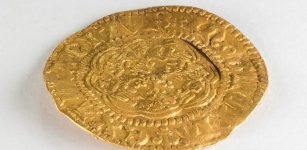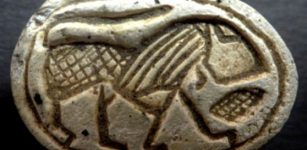On This Day In History: Canute – Cnut The Great – Danish King Of England Died – On Nov 12, 1035
AncientPages.com - On November 12, 1035, King Canute (Cnut The Great) died, a Danish King of England and ruler of one of the largest Nordic empires.
The Viking king had to fight very hard to reach his power.
Cnut reproving the flattery of his courtiers. Cnut the Great (995 - November 12, 1035) was King of Denmark, England, and Norway; often referred to as the North Sea Empire. source
His father, the Danish Viking King Sven Forkbeard (Sven Tveskäg), son of Harald Bluetooth, sailed with his fleet for England in the summer of 1013. He aimed to overthrow the Anglo-Saxon King Aethelred the Redeless and conquer the islands.
Canute proved to be an effective ruler. He divided England into territorial lordships, owing loyalty to the king; he provided a unified governmental system that would last until the Tudors. He stabilized the English coinage by introducing coins of equal weight to Scandinavian currencies, which contributed to thereby encouraging international trade.
He was King of Denmark and England, for a time King of Norway, and possibly lord of parts of Sweden. He was the most powerful king in northern Europe in the early eleventh century.
There is very little historical information about him.
Knut died on November 12, 1035; he was only 40 years old.
Copyright © AncientPages.com All rights reserved. This material may not be published, broadcast, rewritten or redistributed in whole or part without the express written permission of AncientPages.com
More From Ancient Pages
-
 Unusual 300,000-Year-Old Jawbone May Belong To An Unknown Vanished Human Lineage
Archaeology | Dec 18, 2023
Unusual 300,000-Year-Old Jawbone May Belong To An Unknown Vanished Human Lineage
Archaeology | Dec 18, 2023 -
 On This Day In History: Ferdinand Magellan Discovers Guam – On Mar 6, 1521
News | Mar 6, 2017
On This Day In History: Ferdinand Magellan Discovers Guam – On Mar 6, 1521
News | Mar 6, 2017 -
 Four Magical Treasures Of Tuatha De Danann
Celtic Mythology | Jan 23, 2023
Four Magical Treasures Of Tuatha De Danann
Celtic Mythology | Jan 23, 2023 -
 How Did Canada’s Oldest Coin Make Its Way To Newfoundland’s South Coast?
Archaeology | Nov 14, 2022
How Did Canada’s Oldest Coin Make Its Way To Newfoundland’s South Coast?
Archaeology | Nov 14, 2022 -
 Genetic Links Between Traits Are Often Overstated – UCLA Study
Archaeology | Nov 28, 2022
Genetic Links Between Traits Are Often Overstated – UCLA Study
Archaeology | Nov 28, 2022 -
 Massive Roman-Era Column Base Of Limestone Unearthed In The Foothills Of Mount Hermon, Golan Heights
Archaeology | Oct 29, 2022
Massive Roman-Era Column Base Of Limestone Unearthed In The Foothills Of Mount Hermon, Golan Heights
Archaeology | Oct 29, 2022 -
 SPQR Was A Symbol Of The Roman Republic
Ancient History Facts | Dec 4, 2017
SPQR Was A Symbol Of The Roman Republic
Ancient History Facts | Dec 4, 2017 -
 Dearg-Due Frightening Female Demon And Tyrannical Abhartach Of Irish Folklore
Celtic Mythology | Jan 5, 2017
Dearg-Due Frightening Female Demon And Tyrannical Abhartach Of Irish Folklore
Celtic Mythology | Jan 5, 2017 -
 2,000-Year-Old Measuring Table With Stone Weights Unearthed In Jerusalem
Archaeology | Jan 16, 2020
2,000-Year-Old Measuring Table With Stone Weights Unearthed In Jerusalem
Archaeology | Jan 16, 2020 -
 A Stone Age Child Buried With Bird Feathers, Plant Fibers And Fur Investigated In Finland
Archaeology | Nov 2, 2022
A Stone Age Child Buried With Bird Feathers, Plant Fibers And Fur Investigated In Finland
Archaeology | Nov 2, 2022 -
 Czech Neolithic Well Is Oldest Wooden Structure In The World
Archaeology | Mar 11, 2020
Czech Neolithic Well Is Oldest Wooden Structure In The World
Archaeology | Mar 11, 2020 -
 A Scarab Seal At Tel Gerisa, Depicts Walking Lion – Symbol Of Strength, Power And Authority
Archaeology | Sep 5, 2023
A Scarab Seal At Tel Gerisa, Depicts Walking Lion – Symbol Of Strength, Power And Authority
Archaeology | Sep 5, 2023 -
 On This Day In History: Declaration Of Arbroath – The Scots Reaffirm Their Independence – On Apr 6, 1320
News | Apr 6, 2016
On This Day In History: Declaration Of Arbroath – The Scots Reaffirm Their Independence – On Apr 6, 1320
News | Apr 6, 2016 -
 Namoratunga – Kenya’s Fascinating Megalithic Site Oriented Toward Specific Stars And Constellations
Featured Stories | Jul 6, 2021
Namoratunga – Kenya’s Fascinating Megalithic Site Oriented Toward Specific Stars And Constellations
Featured Stories | Jul 6, 2021 -
 Puzzling Ancient Artifacts Found In Canadian Mountains Defy Explanation – Scientists Say
Featured Stories | Aug 27, 2024
Puzzling Ancient Artifacts Found In Canadian Mountains Defy Explanation – Scientists Say
Featured Stories | Aug 27, 2024 -
 Circular Stepped Pyramids Of Guachimontones And Teuchitlan Tradition – A Lost Ancient World In Mexico
Civilizations | Mar 13, 2016
Circular Stepped Pyramids Of Guachimontones And Teuchitlan Tradition – A Lost Ancient World In Mexico
Civilizations | Mar 13, 2016 -
 On This Day In History: Knights Templars’ Jacques de Molay Burned At The Stake – On Mar 18, 1314
News | Mar 18, 2017
On This Day In History: Knights Templars’ Jacques de Molay Burned At The Stake – On Mar 18, 1314
News | Mar 18, 2017 -
 Uruk Was Ruled By Gilgamesh Who Built City’s Great Walls
Featured Stories | Jul 26, 2016
Uruk Was Ruled By Gilgamesh Who Built City’s Great Walls
Featured Stories | Jul 26, 2016 -
 Secrets Of Ninja Swords – Favorite Weapon Of The Shinobi
Featured Stories | Aug 13, 2018
Secrets Of Ninja Swords – Favorite Weapon Of The Shinobi
Featured Stories | Aug 13, 2018 -
 Strange Case Of The ‘Impossible’ Glove Remains Unexplained – The Discovery – Part 1
Featured Stories | May 24, 2019
Strange Case Of The ‘Impossible’ Glove Remains Unexplained – The Discovery – Part 1
Featured Stories | May 24, 2019

